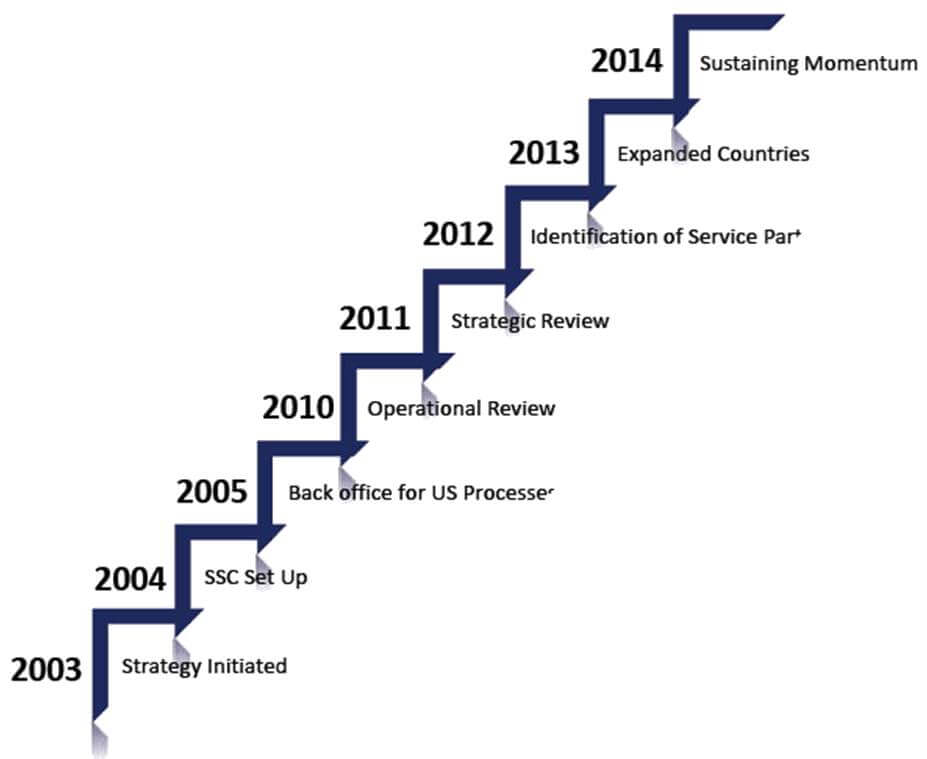
Would you like to start a conversation with other industry leaders to brainstorm a challenge or to just know more on a particular topic?
Engage in online discussions with your Peers
Start NowJust about a year back, the shared services operations at Dr Reddy’s completed a decade of its existence. Along with Dr Reddy’s strategy of going global, there came an opportunity for the finance function to innovate and participate in value creation for the company - be it innovative funding, world class reporting, strengthening the process for new Sarbanes- Oxley Act [SoX] compliance or creating a Shared Service Centre (SSC).
Early Adopter
It is a known fact that Dr Reddy’s has always taken an industry leading initiative in many spheres and the in-house Shared Service Center was one of them. SSC came into existence in 2004, an idea that emerged out of meeting of the global finance team and Dr Reddy’s was one of the early adopters for a manufacturing company to have embarked upon such a strategic initiative in this part of India.
Initially the Accounts Payable and Payroll Process teams, which were located across business units in India, were consolidated together into a 50 FTE SSC. It was a widespread belief in the past that a service function activity in a manufacturing company cannot be measured, but that was proven wrong when the SSC shared its performance and showed a trend of improvement over time. As we gained experience, we established a separate back office for growing our US operations. SoX became mandatory for us and SSC largely met the control requirement that was envisaged in SoX. Further, an updated version of ERP was implemented taking into consideration the SSC process requirements.
Over a period of 5 years, the processes at SSC expanded beyond Accounts Payable and Employee Payments to General Ledger, Accounts Receivables, reconciliations, treasury back office reporting etc. With the consolidation of US and India processes, the SSC was christened Global Business Services (GBS), with plans for bringing processes from other countries in the future.
New Initiative, New Challenges
SSC was always considered as a unit meant to support the operational processes, requiring relatively lower skill elements of  finance. We had issues in attracting talent to this activity. Amongst other things, a challenge we faced was trying to make the transition from a fragmented operation to a process-based single-center operation. SSC functioning is based on moving towards a standardized rules and Processes. Therefore, this was a cultural change as well as a management challenge. Another challenge we faced was to make our employees aware of the processes, adhere to its compliance, and make them augment the functionalities of the SSC. This essentially required a significant management support coupled with series of road shows and training to users across various locations. Along with technological advancement, the company undertook a few IT initiatives and process simplifications, which even called for policy changes at the company level!
finance. We had issues in attracting talent to this activity. Amongst other things, a challenge we faced was trying to make the transition from a fragmented operation to a process-based single-center operation. SSC functioning is based on moving towards a standardized rules and Processes. Therefore, this was a cultural change as well as a management challenge. Another challenge we faced was to make our employees aware of the processes, adhere to its compliance, and make them augment the functionalities of the SSC. This essentially required a significant management support coupled with series of road shows and training to users across various locations. Along with technological advancement, the company undertook a few IT initiatives and process simplifications, which even called for policy changes at the company level!
Strategic Review and Reassessment
Having experienced an in-house SSC for over a period of 5 years, it was time for the Finance team to look at the SSC with a fresh perspective. After analyzing, it was found that SSC had been doing same set of activities of higher volumes, with increased resources and with no or limited advanced tools/ techniques (like workflow). Apart from difficulty of attracting talent, the company also found that for the existing talent, opportunities were limited for people in SSC, who were aspiring for growth in their individual careers.
The Shared Services Operations, which had become 140+ FTE by then, were reviewed – to capture the voice of customer, to improve quality of service, to identify further areas for control enhancements, and a greater focus on capability reinforcements. The Operations achieved a certain level of maturity and given the focus of Dr. Reddy’s as a pharmaceutical company in deep science and technology skills, advanced manufacturing and creating markets for products; it was time to reassess the future plans for SSC.
Thus, in 2012, we evaluated various options for SSC over a period of six months with inputs from industry experts. With supportive tools in place, in 2013, the in-house SSC was outsourced to Genpact, with the clear understanding of service level agreement, productivity improvement and a host of other improvement in existing processes.
Going global and digital in BPM
The most satisfying aspect of this arrangement was that we could facilitate for better career for the team that was involved in SSC. Based on the process stabilization achieved, we gradually added more locations such as Mexico, United Kingdom, Switzerland and more processes from the USA, thus becoming a full-fledged GBS, truly reflecting the global nature of activity carried out by SSC.
Now, a lean team of GBS interfaces with Genpact/ stakeholders on service delivery and process improvements. On regular intervals both the managements review the SSC operations and decide on course correction, if any are required. The company carries out the “Voice of Customer” survey once in a year to get a feedback on the SSC and calibrate the function accordingly.

As a further enhancement of its GBS/ Genpact operations, the company has recently concluded a “Digital P2P” project with the objective of delighting the business partners/ stakeholders. The project, amongst others, gives greater transparency of transaction processing to business partners and any issues they may have with transactions. It also provides an approach to resolve the issues. As a part of this project, we have implemented an online portal where external vendors can enter their invoice directly into the system, thus allowing more focus on prioritized invoice accounting to effect payments on time. It also enables us to figure out spending patterns that highlight possible fraud, and help us analyze better for improving the efficiency of vendor transactions. Another greater advantage is that we intend to eliminate physical documents and go the digitized way – saving cost in document management, indirectly contributing towards ‘GoGreen initiative’.
Value Realization
Looking back, the scope of GBS/SSC has evolved dramatically over the last few years. Today, apart from F&A processes, the SSC handles certain business analytics for our US$ 2Bn+ operations. Though there is growing confidence in current scope, the same is being challenged as technology advances or for meeting dynamic business needs. What is more gratifying is that some of the people who have rebadged into a Genpact role have grown up in their careers and even changed their desks to service other global corporation clients of Genpact. Our expectations from GBS have moved from traditional transaction processing to innovation - setting a benchmark and improving productivity along with technology adoption.
Now our data is more structured with standardized reports, offshore processing of transactions – leading to cost advantage, unified document management, centralized transaction processing, and helping us achieve a productivity of 6% in terms of cost or 16% in FTE in the last two years and a better score in SoX compliance and governance.
In the future, what will carry greater weight in GBS is faster, easier-to-access services that help cut down time spent on non-value adding activities, and allowing us to focus more on critical business activities. The need of the hour at our organization is “Do more with less” and our shared services approach fits perfectly with this philosophy.
ABOUT THE AUTHOR
Suresh VS is part of senior leadership in the Finance team of Dr Reddy’s Laboratories Limited and is associated with the company for over 17 years. He is a qualified Cost & Management Accountant and Company Secretary, and is heading GBS at Dr Reddy’s from 2013. He has handled diverse areas in finance ranging from Financial & Management, ERP implementation, M&A, global taxation, Compliance and Secretarial Practice.




